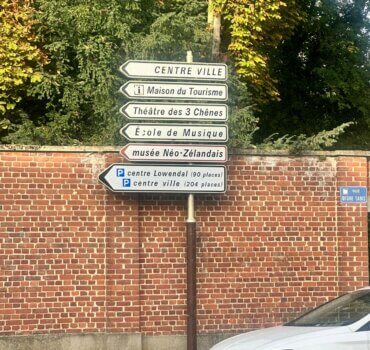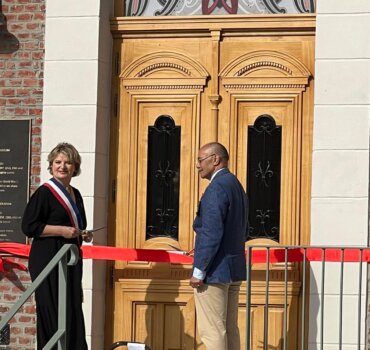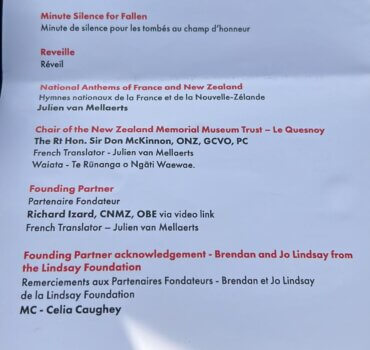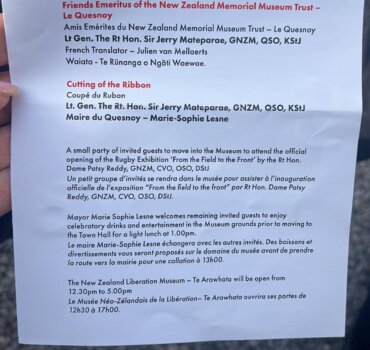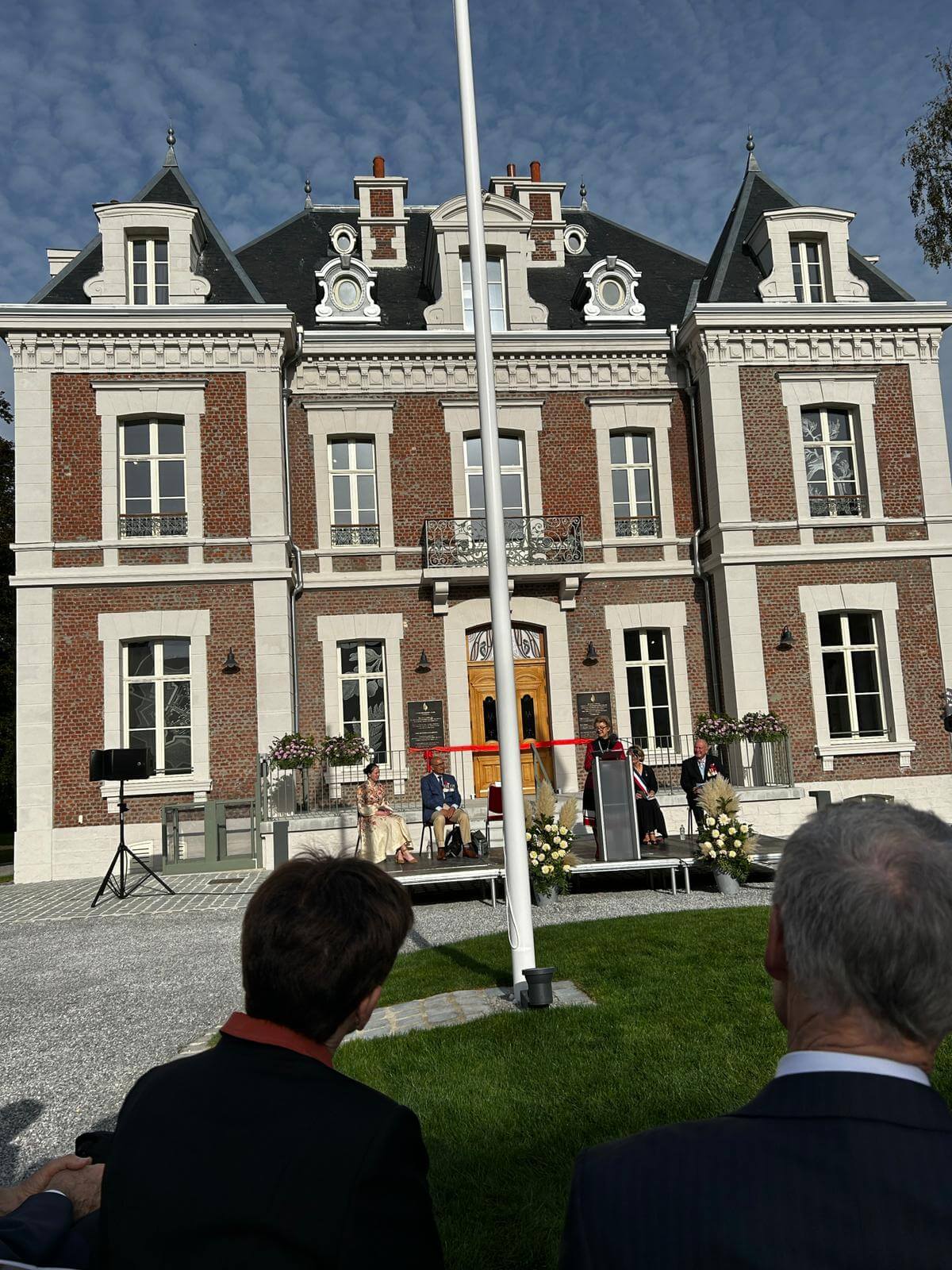
Photo: Susan O’Regan
5am – October 12, 2023 – The Te Arawhata – New Zealand Liberation Museum in Le Quesnoy, northern France has been officially opened by the Rt Hon. Sir Jerry Mateparae and Marie-Sophie Lesne, the Mayor of Le Quesnoy.
The museum was blessed on October 10 by Te Rūnanga o Ngāti Waewae before the official opening on October 11. The blessing in Le Quesnoy also revealed the pounamu cleansing stone at the entrance of the museum which was donated by Te Rūnanga o Ngāti Waewae.
The project has been privately funded through generous donations – including $150,000 from Wāipa District Council – and fundraising continues with the aim of reaching beyond the $15 million target.
Cambridge and Le Quesnoy are sister cities. A Le Quesnoy delegation will be in Cambridge for Armistice Day commemorations.
See: Seeing our sisters
See: Don’t let the bed bugs bite

The NZ Liberation Museum – Te Arawhata opened by the Rt Hon. Sir Jerry Mateparae and Marie-Sophie Lesne, the mayor of Le Quesnoy..
Founding partner Richard Izard, who has contributed $3.5 million spoke at the event via video message and was represented in Le Quesnoy by his great niece, Felicity Wilson. Eleven-year-old May Upton from New Zealand helped Sir Jerry and Madame Lesne to cut the ribbon.
Rugby exhibition, From the Field to the Front, which is located in a separate gallery inside the museum, also opened on October 11 and tells the story of All Blacks who served in World War One and highlights the place the game holds in New Zealand’s cultural fabric.
Wētā Workshop has developed the visitor experience for the new museum.
There are three key exhibits:
- an enormous sculpture of a soldier who holds winter flowers from Northern France, representing freedom
- a wall of remembrance inspired by tukutuku panels, which symbolises friendship; and
- Te Arawhata (The Ladder), a beautiful, large-scale museum showpiece which looks to the future.
The New Zealand Memorial Museum Trust – Le Quesnoy has driven the $15 million development.
Chairperson Sir Don McKinnon says: “The NZ Liberation Museum – Te Arawhata was built on freedom, friendship, and the future. This is New Zealand’s first memorial museum in Europe for our soldiers, but it is also a place for not only Kiwis, but people from around the world, to visit and celebrate freedom, friendship and the importance of learning from the past to support a better future.”
The name of the museum was inspired by the inventive Kiwi soldiers who scaled the town walls with a ladder on 4 November 1918 to free Le Quesnoy’s residents from a four-year German occupation.
Although no civilian lives were lost thanks to this creative strategy, many New Zealand soldiers were killed and are buried in the Le Quesnoy cemetery.

l-r Curtis Reymer of Ohaupo wearing his St John’s College, Hamilton uniform, his mother Waipa deputy mayor Liz Stolwyk, Sir Lockwood Smith, Waipa mayor Susan O’Regan, Sir Timothy Laurence, at the opening of the Te Arawhata – New Zealand Liberation Museum in Le Quesnoy. Photo: Supplied.

L-r Brendan Lindsay (Cambridge Stud), Jo Davies-Colley (Cambridge Community Board), Susan O’Regan (Waipa mayor), Dame Patsy Reddy, Liz Stolwyk (Waipa deputy mayor) and son Curtis Reymer, Marie-Sophie Lesne (Le Quesnoy mayor).
- Cambridge Community Board chair Jo Davies-Colley with her mother Neva Summers
- Cambridge Community Board chair Jo Davies-Colley with Helene Lebon.
- Cambridge Community Board chair Jo Davies-Colley
- Cambridge Community Board chair Jo Davies-Colley, deputy mayor Liz Stolwyk, mayor Susan O’Regan.
- TheNZ Liberation Museum – Te Arawhata opened by the Rt Hon. Sir Jerry Mateparae and Marie-Sophie Lesne, the mayor of Le Quesnoy.openng.Photo: Jo Davies-Colley
- Photo: Jo Davies-Colley
- Photo: Jo Davies-Colley
- Photo: Jo Davies-Colley
- The NZ Liberation Museum – Te Arawhata opened by the Rt Hon. Sir Jerry Mateparae and Marie-Sophie Lesne, the mayor of Le Quesnoy..
- The NZ Liberation Museum – Te Arawhata opened by the Rt Hon. Sir Jerry Mateparae and Marie-Sophie Lesne, the mayor of Le Quesnoy..
- Rt Hon. Sir Jerry Mateparae
- Rt Hon. Sir Jerry Mateparae and Curtis Reymer.
- Marie-Sophie Lesne, the mayor of Le Quesnoy.
10.15pm October 11, 2023 – the Opening Cermony is underway
- Official opening of NZ Liberation Museum – Te Arawhata. Photo: Susan O’Regan
- Order of Ceremony: Photo: Susan O’Regan
5.40pm October 11, 2023 – Inside the Museum
Cambridge features prominently at the Te Arawhata – New Zealand Liberation Museum in Le Quesnoy as these photos inside the Friendship Room show.
- Photo: Susan O’Regan
- Photo: Susan O’Regan
- Photo: Liz Stolwyk
- Photo: Liz Stolwyk
- Photo: Liz Stolwyk
- Photo: Liz Stolwyk
- Photo: Liz Stolwyk
- Photo: Liz Stolwyk
- Photo: Liz Stolwyk
- Photo: Liz Stolwyk
- Photo: Liz Stolwyk
- Photo: Liz Stolwyk
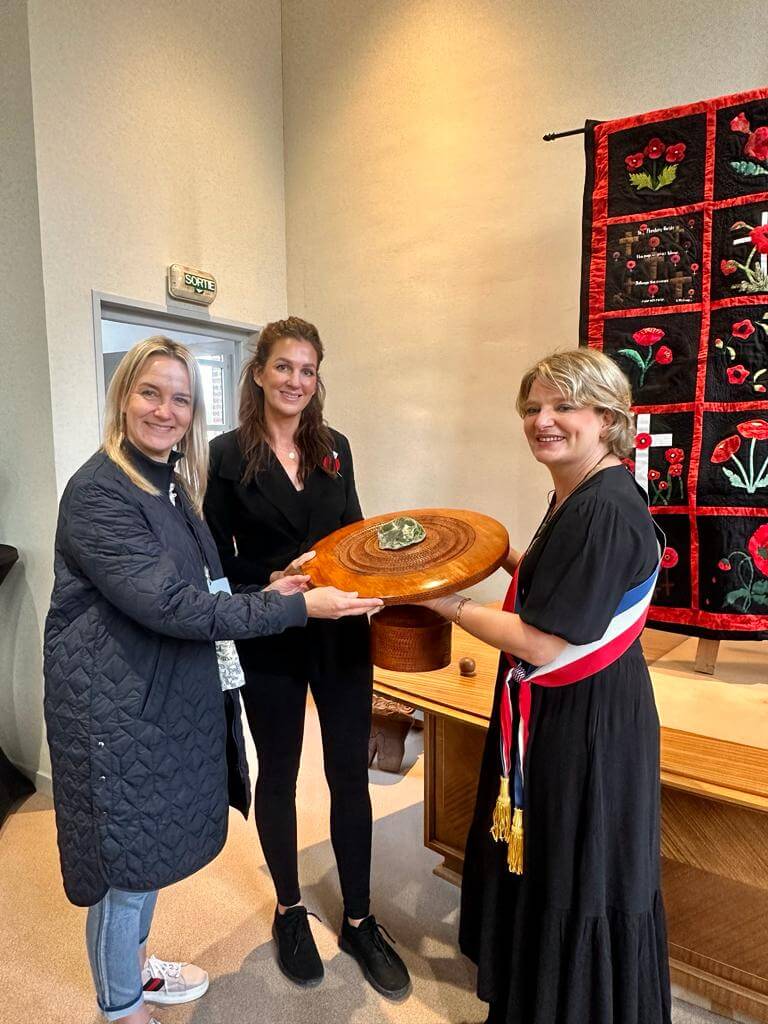
Waipa mayor Susan O’Regan, Cambridge Community Board chair Jo Davies-Colley and Le Quesnoy mayor Marie Sophie Lesne with the poppy bowl gifted from Cambridge, New Zealand.
7.30pm – 10 October, 2023 – The Waipā delegation of mayor Susan O’Regan, deputy mayor Liz Stolwyk and Cambridge Community Board chair Jo Davies-Colley have arrived in Le Quesnoy for a dawn ceremony in advance of Te Arawhata – New Zealand Liberation Museum’s opening.
Afterwards they gifted a poppy bowl to the mayor of Le Quesnoy, Marie-Sophie Lesne.
“It will be for the people of Le Quesnoy, and the mayor will find an appropriate place for it to be displayed. They are very excited,” Davies-Colley said.
New Zealanders, descendants of Kiwi soldiers, locals, and dignitaries gathered for the dawn blessing of the NZ Liberation Museum – Te Arawhata by Te Rūnanga o Ngāti Waewae.
The stunning pounamu cleansing stone donated by Te Rūnanga o Ngāti Waewae greeted visitors at the entrance to the museum.
See: Jimmy’s bowl heads to France.
See: Don’t let the bed bugs bite
See: RSA stages treble ceremony

Madame Mayor Marie Sophie Lesne presenting Sir Don McKinnon with a medal from Le Quesnoy while Raymonde Dramez watches on. Photo: Susan O’Regan.
The New Zealand Liberation Museum – Te Arawhata, located in a small French town that was occupied by Germany during World War One, is not just about war.
It symbolises freedom, friendship, and the future.
Wētā Workshop created the visitor experience for the new museum and has revealed a first look at three major exhibits that reflect these themes ahead of the official opening on October 11 in Le Quesnoy.
A giant soldier holding winter flowers from Northern France depicts freedom; a remembrance wall inspired by tukutuku panels signifies friendship; and Te Arawhata, which translates to The Ladder, is a stunning, large-scale centrepiece of the museum highlighting the future.

Cambridge Community Board chair Jo Davies-Colley reunites with the poppy bowl she sent to France in May.

Le Quesnoy mayor Marie Sophie Lesne leads from l-r Liz Stolwyk, Susan O’Regan and John Hayward to the dawn ceremony.

The museum was blessed by Te Rūnanga o Ngāti Waewae ahead of the official opening on October 11. The blessing in Le Quesnoy revealed the pounamu cleansing stone at the entrance of the museum which was donated by Te Rūnanga o Ngāti Waewae.
“The NZ Liberation Museum – Te Arawhata was built on freedom, friendship, and the future,” says Sir Don McKinnon, chairperson of the New Zealand Memorial Museum Trust – Le Quesnoy which is behind the creation of the $15 million project.
“This is New Zealand’s first memorial museum in Europe for our soldiers, but it is also a place for not only Kiwis, but people from around the world, to visit and celebrate freedom, friendship and the importance of learning from the past to support a better future.”
The museum takes its name from the resourceful way Kiwi soldiers used a ladder to scale the walls of the town on 4 November, 1918, to liberate the people of Le Quesnoy from four years of German occupation. While this unique approach helped to ensure no civilian lives were lost, many New Zealand soldiers died and are buried in the cemetery in Le Quesnoy.
On October 10 and 11, Le Quesnoy will be packed with New Zealanders for the opening of the museum.
Dignitaries, descendants of Kiwi soldiers involved in the liberation of Le Quesnoy, donors who have supported the project, and members of the public, will be there to acknowledge a friendship that began over 100 years ago.

Museum celebration, from left Waikato University’s Nathalie Philippe, Liz Stolwyk and Le Quesnoy cultural coordinator Hélène Lebon at a function on the eve of the New Zealand Liberation Museum opening. Photo: Supplied.
NZ Liberation Museum – Te Arawhata will be opened by the Rt Hon. Sir Jerry Mateparae and Marie-Sophie Lesne, the mayor of Le Quesnoy.
“Wētā Workshop, with their vast expertise in crafting immersive worlds have created a multi-sensory experience that connects visitors to the liberation of Le Quesnoy as well as commemorating the 12,500 Kiwis who died in France and Belgium during World War One,” said Sir Don.
The museum will be blessed on October 10 by Te Rūnanga o Ngāti Waewae ahead of the official opening on October 11. The blessing in Le Quesnoy will also reveal the pounamu cleansing stone at the entrance of the museum which was donated by Te Rūnanga o Ngāti Waewae.
The official opening will be attended by dignitaries including Vice Admiral Sir Tim Laurence (husband to Anne, The Princess Royal); the Rt Hon. Dame Patsy Reddy (Chair of New Zealand Rugby); Clare de Lore, Lady McKinnon; Sir Lockwood Smith and Lady Alexandra Smith; George Hickton (Chair of Wētā Workshop); Andrew Thomas (Senior creative director Wētā Workshop); Tracey Collis (Mayor of Tararua District Council); Susan O’Regan (Mayor of Waipa District Council); Grant Smith (Mayor of Palmerston North City Council); Sir Wayne “Buck” Shelford (National President NZ RSA); and families who are descendants of soldiers involved in the liberation of Le Quesnoy.
Founding partner Richard Izard, who has contributed $3.5 million will speak at the event via video message and be represented in Le Quesnoy by his great niece, Felicity Wilson.
Founding partners Brendan and Jo Lindsay, of the Lindsay Foundation, who have contributed $3.5 million will be at the opening ceremony and events.
The project has been privately funded through generous donations and fundraising continues with the aim of reaching beyond the $15 million target.
Also opening on October 11 is From the Field to the Front, a rugby exhibition located in a separate gallery inside the museum which tells the story of All Blacks who served in World War One and highlights the place the game holds in New Zealand’s cultural fabric.

A video plays inside the Le Quesnoy museum featuring Cambridge’s sister-city relationship. It shows Grahame Webber laying a wreath. Photo: Liz Stolwyk.
Marie-Sophie Lesne, the mayor of Le Quesnoy, says the museum is a symbol of what friendship, nurtured by the people of Le Quesnoy and New Zealand throughout the years, can achieve.
“It will be a second victory for peace and freedom and we all gratefully welcome this wonderful place that our New Zealand friends are giving us.”
Madame Lesne says the New Zealand Liberation Museum – Te Arawhata is a strategic and extremely important monument for Le Quesnoy and its region.
“It will broaden the cultural offer significantly and help us become a more prosperous and attractive town,” she says.
Willie Apiata, VC, a supporter of the museum project, says the heroic actions of New Zealand soldiers who liberated Le Quesnoy is an important story in the country’s history.
“As a person who has served and experienced conflict, I have seen first-hand the tragedies of war. Te Arawhata is a place where the historic stories of our brave New Zealanders will be told, revisited, and remembered as we build a united peaceful future together.”
MORE THAN A MUSEUM
“Te Arawhata is not just a museum,” says Wētā Workshop Senior Creative Director, Andrew Thomas. “It’s a living testament to the unbreakable bonds forged between nations in times of adversity.”
He says by paying meticulous attention to historical accuracy and artistic craftsmanship, the Wētā Workshop team aimed to transport visitors back in time.
“The exhibit allows them to stand alongside the brave soldiers who fought for freedom. This living memorial encapsulates the essence of unity and sacrifice, and we are honoured to bring this narrative to life.”
THE ENCOUNTER ROOM
Freedom
Similar to the hyper-realistic soldiers Wētā Workshop created for Gallipoli: The Scale of Our War exhibition at Te Papa in Wellington, a large-scale New Zealand Rifle Brigade Soldier is one of the first figures visitors encounter when they enter the museum.
Crafted using the latest technological innovations in manufacturing, the soldier sits on a cobblestone footpath, his rifle placed gently by his side, as he is caught in a moment of deep reflection following the liberation.
WE WILL REMEMBER THEM
Friendship
On the second level of the museum, a room lined with colourful tukutuku-inspired panels is a space where visitors can leave personal messages on the walls to be read by those who follow them.
The colour of the panels is inspired by the winter flowers the people of Le Quesnoy pinned to the soldiers after the liberation.
The courage of the Kiwi soldiers created a special bond between the people of Le Quesnoy and New Zealand. To this day, several names in the town are inspired by New Zealand including Place des All Blacks and Rue du Dr Averill (after Second Lieutenant Leslie Averill who was the first to ascend the ladder).
Also, every year, the people of Le Quesnoy mark Anzac Day in remembrance of the Kiwis who liberated their town.
TE ARAWHATA SCULPTURE
Future
While Te Arawhata – the ladder – is integral to the Le Quesnoy story, it also represents a pathway to gaining a higher level of knowledge.
Extending centrally up through the museum stairwell, the translucent and reflective materials used to craft the 7.4m ladder creates a dynamic and captivating space for visitors as they ascend to the second level with rooms designed for reflection and to provide greater understanding.









